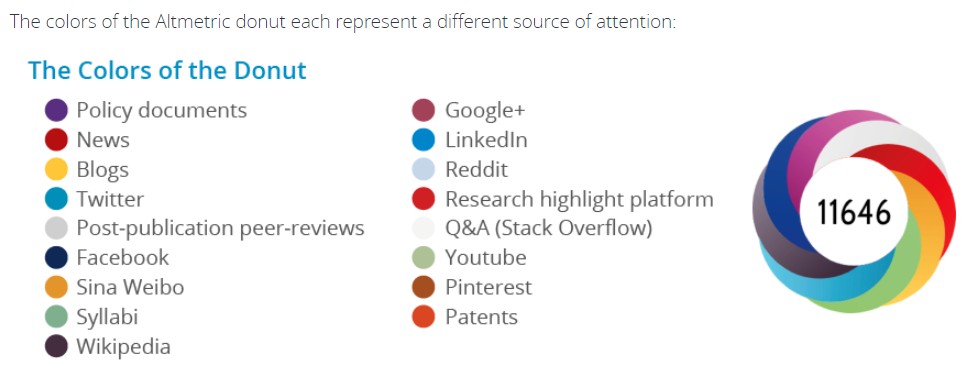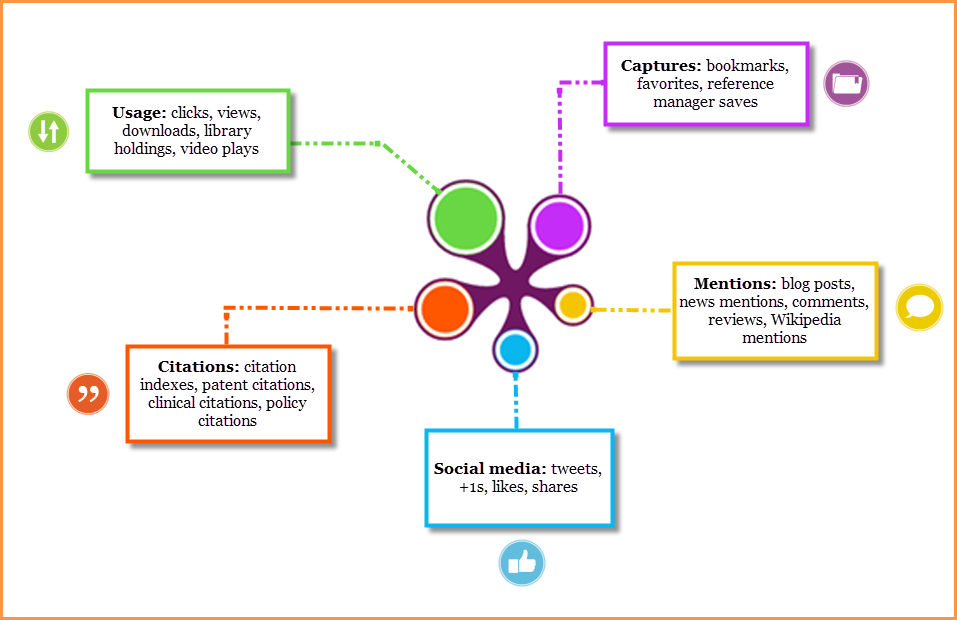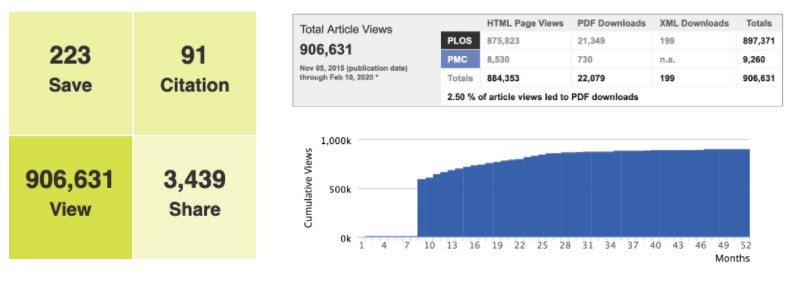常見研究評估指標
透過指標與資源介紹,了解如何使用傳統指標(書目計量學)和替代性計量學(Altmetrics)評估研究影響力。
書目計量學
以書目、目錄和主題為對象,利用統計、數學和邏輯方法,對它們所涵蓋的特質,作個別或集體的研究和分析,此方式常被用於傳統的學術評估指標,例如:被引次數、Journal Impact Factor, H-index, SJR, FWCI等,皆是利用書目計量學方法統計而成。
研究影響評估相關指標
- Citation 被引次數:
某文章出現在其他出版品之參考文獻次數。
- FWCI 領域權重引用影響係數 (Field-Weighted Citation Impact, FWCI) :
指依相同學科領域、同出版年與同文獻類型做比較而得出來的標準化平均引用次數,來源為Scopus資料庫。
- 影響指數(Impact factor, IF):
指的是某一期刊的文章在特定年份或時期被引用的頻率,是衡量學術期刊影響力的一個重要指標,來源為InCites JCR資料庫。
- H指數 (H-index):
定義為有 h 篇文章至少被引用 h 次以上的文章,簡單易懂的評估指標,不像平均值會受極值影響,反而可呈現出多數文章的被引用表現。
研究影響評估相關系統、資源
各領域資料庫期刊清單
Altmetrics
Altmetrics即為Alternative Metrics,可譯為替代性計量學、網路計量學…等,因應網路環境,為補充傳統學術評估之不足,利用工具蒐集統計單一文章或作者在網路被關注、談論、閱讀、下載、引用、推薦、分享…等線上行為。因利用蒐集之工具不同,所蒐集統計之線上行為項目與分類亦不同,校內常見的有 Almetric.com、PlumX Metrics 及 PLoS Article Level Metrics, ALMs 三種。以下各別進行介紹。
Almetric.com
圖示以多種色彩組成貌似甜甜圈的Altmetric徽章,每一種線上行為項目皆以特定顏色代表,顏色越豐富,代表該篇文章的Altmetrics資料來源越多,中間數值越大,代表該文章的影響力越大。以下為其圖示範例。

資料來源: The donut and Altmetric Attention Score
提供此指標的資源: 北醫學術知識庫暨專家研究網
PlumX Metrics
圖示為一朵花的樣子,各花瓣各別代表以下來源:
- 橘色=引用:citation indexes, patent citations, clinical citations, policy citations
- 綠色=使用率:clicks, downloads, views, library holdings, video plays
- 紫色=擷取:bookmarks, code forks, favorites, readers, watchers
- 黃色=提及與談論:blog posts, comments, reviews, Wikipedia references, news media
- 藍色=社群媒體:shares, likes, comments, tweets

資料來源: About PlumX Metrics
提供此指標的資源: 北醫學術知識庫暨專家研究網 , Scopus , Science Direct
PLoS Article Level Metrics, ALMs
ALMs是文章層級的評估指標,主要是PLOS出版社使用之工具,每篇文章統計不同之線上行為項目與來源,如下所示:
- 檢視(Viewed): PLOS Journals (HTML, PDF, XML), PubMed Central (HTML, PDF)
- 被引(Cited): CrossRef, Datacite, Europe PMC, PubMed Central, Scopus, Web of Science
- 提及與討論(Discussed): PLOS Comments, Facebook, Reddit, Twitter, Wikipedia
- 儲存(Saved): CiteULike, Mendeley
- 推薦(Recommended): F1000 Prime

資料來源: Metrics - PLOS
提供此指標的資源: PLOS.org
服務窗口:
資料庫使用問題
北醫圖參考服務台
位置: 信義校區醫學綜合大樓後棟三樓(館內第二樓層)
電話: (02) 2736-1661 #2515
信箱: asktmul@tmu.edu.tw
研究影響評估指標問題
知識服務組 蕭淑媛小姐
電話: (02) 2736-1661 #2517
信箱: a9010015@tmu.edu.tw
Last updated: 2022-08-23